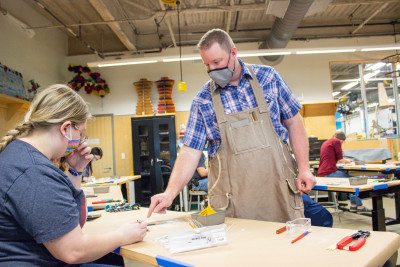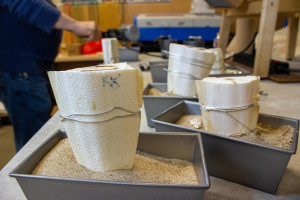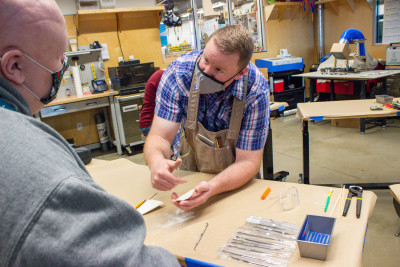Meet the Maker: Chase Young
Makers in Residence at the Scott Family Amazeum bring diverse skill sets and backgrounds with them when they arrive. Chase Young, who lead sessions in the Workshop on molding and casting, is no exception.
Young was born and raised in the desert Southwest. From a young age, he had a passion for creating and making and pursued this passion in many directions from custom automotive work to hand-crafted cabinetry before discovering the unrestricted possibilities for creativity within the field of contemporary sculpture. After earning his Bachelors of Fine Art from Arizona State University, Young obtained a Masters of Fine Art at the University of Arkansas. His artwork incorporates a variety of materials and media to explore the strangeness of humanity's constructed environment.
Like many people who identify as makers, craftspeople, and creatives, Young’s interest in how things work, and how materials can be manipulated and repurposed creatively, began at an early age. “I started taking things apart and not necessarily putting them back together. I’ve always been interested in how things work,” Young says. Tinkering lead to acquiring knowledge of not only the tools and materials, but also the process of discovering how things work and a passion for creating by putting things together. “I live to make, to create. I’ve always got a number of projects going at the same time,” Young says.
Time spent building custom wood cabinetry and automotive work developed woodworking and welding skills to complement Young’s formal studies in sculpture and creative arts. “I’m a sculptor, a maker, an educator, a fabricator,” Young says. “I fabricate in any material I can get my hands on and learn about.”
"I started taking things apart and not necessarily putting them back together. I've always been interested in how things work."
Young introduced the Amazeum community to cuttlebone casting, a process where the soft bone of a Cuttlefish is used to create a mold in which molten pewter is poured to cast a metal object. Until the development of modern digital technology like 3D printers and other computer-controlled devices, molding and casting was an efficient way to replicate three-dimension objects and produce durable parts and pieces. A traditional art form and utilitarian process, molding and casting continues as an integral part of manufacturing and sculpting and often combines the digital and analog technology.
the soft bone of a Cuttlefish is used to create a mold in which molten pewter is poured to cast a metal object. Until the development of modern digital technology like 3D printers and other computer-controlled devices, molding and casting was an efficient way to replicate three-dimension objects and produce durable parts and pieces. A traditional art form and utilitarian process, molding and casting continues as an integral part of manufacturing and sculpting and often combines the digital and analog technology.
“I’m looking for ways the two can translate. I’m not super interested in digital processes by themselves unless I can find a way to work handcraft in,” Young says. Cuttlebone casting combines the organic and inorganic to produce something that melds the qualities of both. During the workshop sessions, guests were able to carve designs directly into the cuttlebone or impress 3D printed objects into the soft skeleton to make the mold. When the hot metal is poured into the soft cuttlebone, some of the bone is singed leaving a unique texture on the metal. “You take something rigid and digital and give it a more organic feel in the casting process,” Young explains. The process adds some organic imperfections to the crisp precision of digitally created objects.
 When asked to define a maker, Young puts a premium on passion and creativity. “For me, a maker is someone who’s constantly driven to create,” Young says. He recognizes that the tradition of making hasn’t always been aligned with creativity but with necessity. Historically, when something broke or a tool needed, it was often made by hand. “I define a maker as someone who’s passionate enough about creativity to do it when they don’t have to,” Young continues.
When asked to define a maker, Young puts a premium on passion and creativity. “For me, a maker is someone who’s constantly driven to create,” Young says. He recognizes that the tradition of making hasn’t always been aligned with creativity but with necessity. Historically, when something broke or a tool needed, it was often made by hand. “I define a maker as someone who’s passionate enough about creativity to do it when they don’t have to,” Young continues.
In many respects, making bridges the gap between art and craft and creativity and utility that connects traditional processes and skills with modern technologies to provide new opportunities for creative expression.
Discover more about Makers in Residence and Maker Sessions here.







